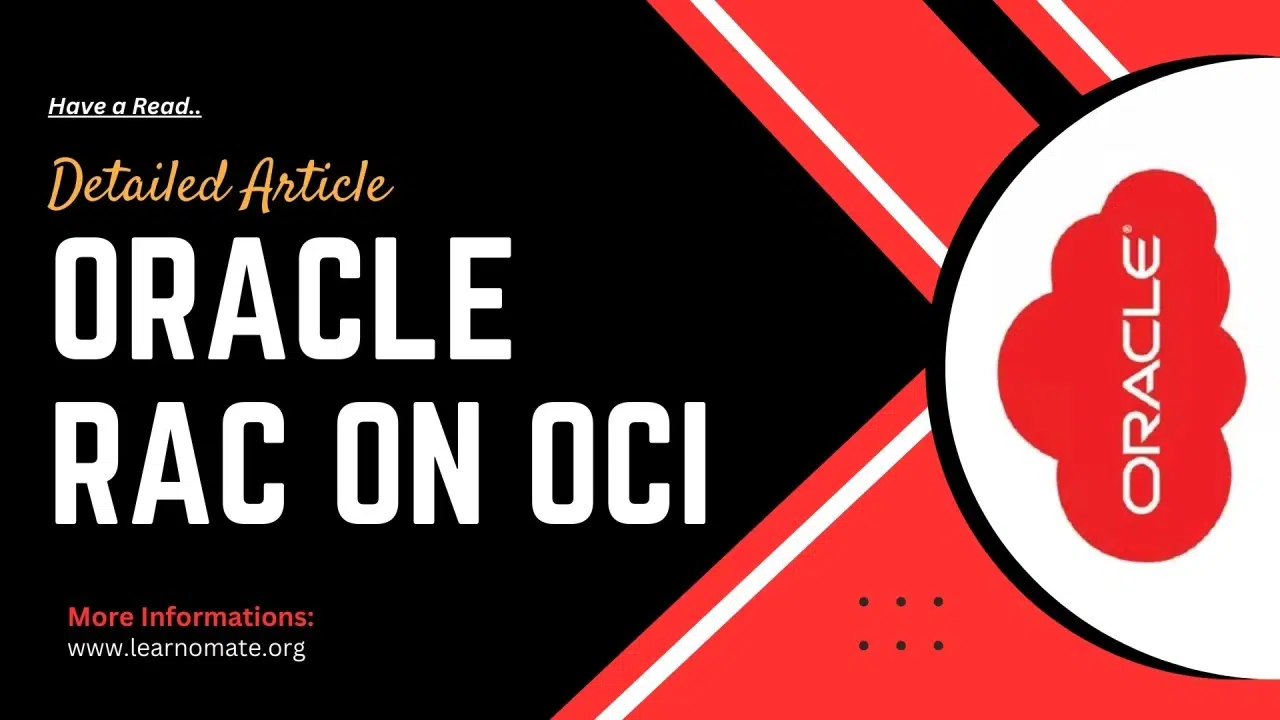Oracle RAC on OCI: Reliable & Scalable Databases
Introduction
Having spent years managing critical databases, I know firsthand how crucial high availability (HA) and failover capabilities are. Oracle Real Application Clusters (RAC) has always been my go-to solution for ensuring continuous database operations. But when deployed on Oracle Cloud Infrastructure (OCI), it becomes an absolute game-changer.
Imagine you are running an online stock trading platform where millions of trades happen every minute. Any system downtime, even for a few seconds, can result in financial losses worth millions. Traditional database systems often struggle to provide real-time failover, leading to costly disruptions. This is where Oracle RAC on OCI comes in. By distributing workloads across multiple nodes and ensuring automatic failover, it guarantees that your database remains operational even if a node fails.
Today, let’s explore why running Oracle RAC on OCI simplifies high availability and how you can leverage it for your mission-critical applications.
What is Oracle RAC?
Oracle Real Application Clusters (RAC) is an option for Oracle Database that enables multiple servers to run a single database simultaneously. This setup ensures that if one node fails, the others continue to operate seamlessly, providing fault tolerance, load balancing, and scalability. I’ve personally seen how this architecture minimizes downtime in production environments, making it a lifesaver for enterprises handling large-scale transactions.
Why Run Oracle RAC on OCI?
Running Oracle RAC on Oracle Cloud Infrastructure (OCI) offers several advantages:

- Native Support for RAC: OCI is designed to handle Oracle RAC workloads efficiently.
- Automated Failover and Load Balancing: The infrastructure is optimized to automatically redistribute workload in case of node failure.
- Lower TCO (Total Cost of Ownership): Unlike on-prem deployments, OCI eliminates the need for expensive physical hardware and maintenance.
- High-Speed Networking: OCI’s RDMA (Remote Direct Memory Access) provides ultra-low latency, improving interconnect speeds between RAC nodes.
- Built-in Security and Compliance: OCI is designed with enterprise-grade security features, ensuring your databases are protected against threats.
Architecture of Oracle RAC on OCI
The architecture of Oracle RAC on OCI consists of:
- Two or More Compute Nodes: These nodes run the RAC database instances.
- Clustered File System (ASM): Automatic Storage Management (ASM) is used for shared storage.
- FastConnect or VPN: For secure and low-latency connectivity.
- Load Balancers: Distributes the application workload across multiple RAC nodes.
- OCI Block Storage and Object Storage: Used for database storage and backups.
Real-World Scenario: Banking Systems
During my time working with banking clients, I’ve seen the sheer pressure they face in ensuring 24/7 database availability. Imagine handling thousands of transactions per second—any downtime could mean massive financial and reputational losses. With Oracle RAC on OCI, even if one database node crashes, another immediately takes over, ensuring seamless transactions. This is exactly why major banks trust this setup.
Deployment Best Practices
To get the best out of Oracle RAC on OCI, follow these best practices:
- Choose the Right Compute Shape: Use OCI’s database-optimized shapes such as BM.DenseIO for better performance.
- Configure Proper Load Balancing: Implement OCI Load Balancer to distribute traffic evenly.
- Use Data Guard for Disaster Recovery: Pair Oracle RAC with Data Guard to enable failover in case of regional failures.
- Enable Automatic Scaling: OCI’s Auto Scaling feature allows dynamic resource allocation.
- Monitor Performance with Oracle Cloud Monitoring: Track CPU, memory, and IOPS to optimize performance.
Performance Analysis
A study by Oracle revealed that deploying RAC on OCI reduced database downtime by 60% compared to traditional on-prem deployments. I’ve also spoken with several enterprise clients who reported up to 40% cost savings due to OCI’s pay-as-you-go model. This level of efficiency is hard to ignore.
Challenges and Solutions
1. Interconnect Latency
Challenge: High latency between RAC nodes can impact performance. Solution: OCI’s RDMA networking significantly reduces interconnect latency, improving RAC efficiency.
2. Complexity in Setup
Challenge: RAC deployments can be complex. Solution: OCI provides preconfigured images and templates to simplify the setup.
3. Data Loss in Disaster Scenarios
Challenge: Data loss is a major concern. Solution: OCI’s integration with Oracle Data Guard ensures complete disaster recovery.
Real-Time Use Case: E-Commerce Application
One of the largest e-commerce companies in India recently moved their Oracle RAC setup to OCI. Previously, they faced frequent downtimes during high sales periods (such as festive sales). After migrating to OCI, they reported a 99.99% uptime and significant improvement in database performance, allowing them to handle peak loads seamlessly. Seeing such transformations firsthand makes it clear why businesses are making this move.
Related News & Trends
As per Gartner’s 2023 report, over 70% of enterprises running Oracle Databases are planning to shift to OCI in the next five years due to its high availability features. Companies like JPMorgan Chase and Zoom are leveraging Oracle’s cloud solutions for their mission-critical workloads.
Conclusion
If you are looking for a reliable, scalable, and highly available database solution, Oracle RAC on OCI is the perfect choice. With its built-in failover, load balancing, and performance optimizations, you can ensure uninterrupted service for your mission-critical applications. Whether you’re running a banking system, an e-commerce platform, or a large enterprise application, OCI provides the robust infrastructure to support your needs efficiently.
At Learnomate Technologies Pvt Ltd, we provide the best hands-on training for Oracle RAC on OCI, helping you gain the practical skills needed to excel in the industry. Our expert-led training programs cover real-world deployment scenarios, troubleshooting techniques, and performance optimization strategies.
For more insights, check out our YouTube channel: www.youtube.com/@learnomate.
Interested in professional training? Visit our Oracle DBA 19c training page: https://learnomate.org/training/oracle-dba-19c-training/.
Follow me on LinkedIn for more industry updates: https://www.linkedin.com/in/ankushthavali/.
If you want to read more about different technologies, explore our blog section: https://learnomate.org/blogs/.
Ready to master Oracle RAC on OCI? Let’s get started!
Regards🙌
Tech Team
LEARNOMATE😎

